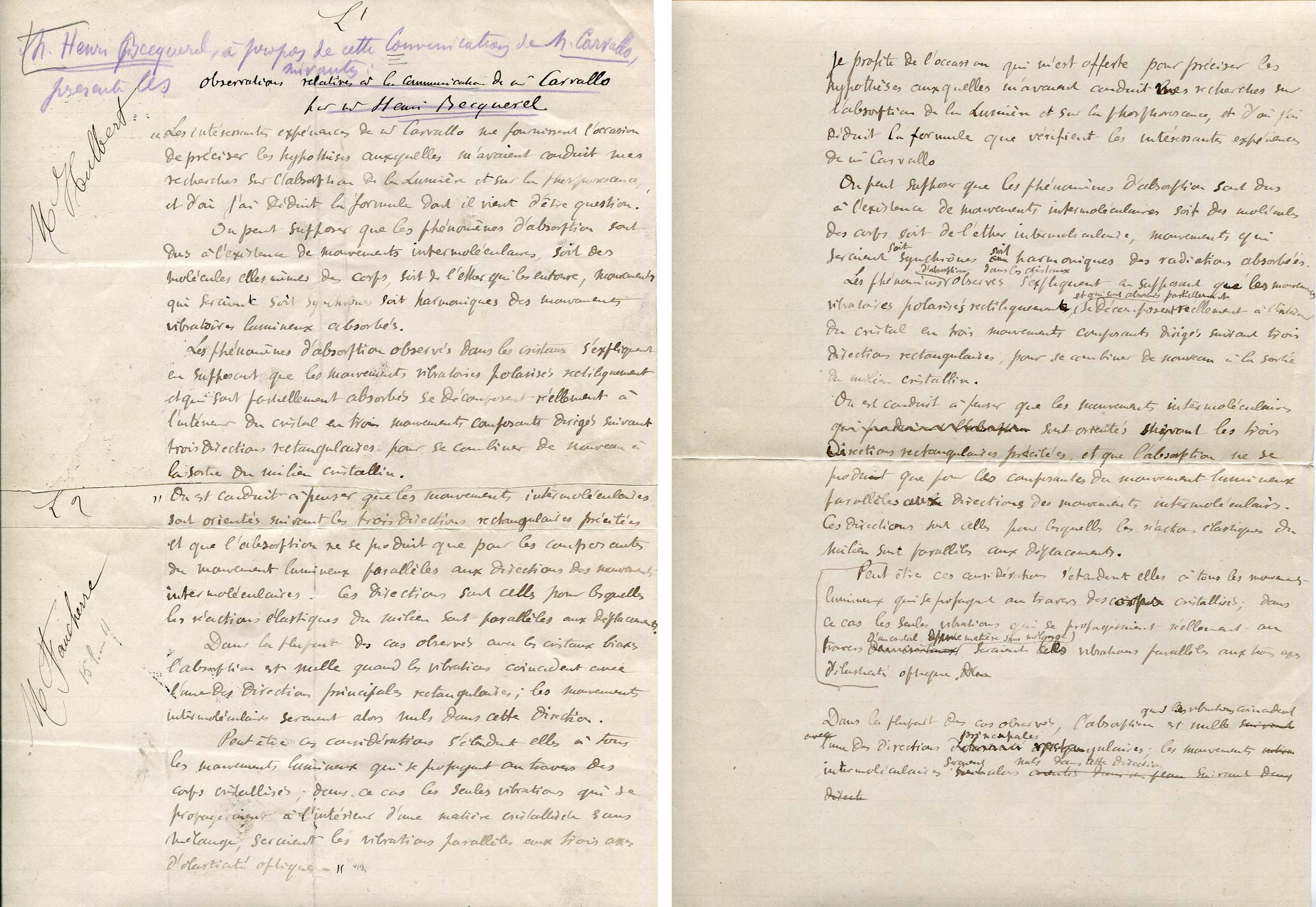Description
Autograph manuscript signed, two pages - on ruled cream paper, 8,75 x 13,5 inch, ca. 1890*, in French, scientific manuscript (with numerous amendments) entitled `Observations relative to the communication of M. Carvallo** by M. Henri Becquerel` (translated) - we propose that this manuscript is two versions or drafts of the same piece, written and signed in dark ink "M. Henri Becquerel" - several inscriptions located in the margins and at the top of one page (in purple coloured pencil) were done in another hand, with expected intersecting letter folds, isolated grime including scattered fingerprints, and one of the pages was cut horizontally along the center and later repaired verso - in nearly fine condition. Accompanied by an additional certificate of autheticity from University Archieves.
Translated (in parts):
"Observations relative to the communication of M. Carvallo by M. Henri Becquerel
The interesting experiments of M. Carvallo furnish me with the opportunity to more precisely explain the hypotheses to which I had conducted my research on the absorption of Light and on phosphorescence, and from where I deduced the formula of which there is no question.
One can suppose that the phenomena of absorption are due to the existence of intermolecular movements, either from the bodies of the molecules themselves, or from the ether which surrounds them, movements that would be either synchronous or harmonic to the vibratory light-absorbing movements [`des mouvements vibratoires lumineux absorbés`].
The phenomena of absorption observed in crystals can be explained in supposing that the vibratory movements, polarized rectilinearly and which are formally absorbed, break down in the interior of the crystal in three movements, the directed components of which follow three rectangular directions, in order to combine anew once exited from the crystalline environment.
One is compelled to think that the intermolecular movements are oriented along the three rectangular directions and that the absorption is only produced by the components of the movements of light running parallel to the direction of the intermolecular movements. These directions are those for which elastic reactions from the environment are parallel to the displacements.
In the majority of the observed cases with the biaxial crystals, there is no absorption when the vibrations coincide with one of the principal rectangular directions; the intermolecular movement would also be nil in this direction.
Perhaps these considerations extend to the movement of light spreading through crystallized bodies; in this case the only vibrations spreading to the interior of unadulterated crystal matter, would be vibrations running parallel to the three axes of optical elasticity..."
* This manuscript probably dates from the 1890s, when European physicists like Becquerel, Carvallo, Woldemar, Voigt, Sir David Brewster, and others were making great strides in the fields of crystallography and optics.
** Moise Emmanuel Carvallo was a French mathematician and astronomer, and like Becquerel, also came from a family of scientists. Carvallo submitted his thesis on optical theory to the Sorbonne in 1890, and in the same year, became a mechanical envestigator at the Polytechnical School in Paris.
Manuscripts signed by Becquerel with similar outstanding scientific content are unusual, while manuscripts of this length - approximately 500 words - are even more rare. Two successive drafts of the same treatise permit the layman to see Becquerel's actual writing process, from scientific ideation to explication, by way of more than a dozen of Becquerel's edits, strikethroughs, and rewordings. This treatise testifies to the competitive and collaborative nature of scientific inquiry. The treatise was Becquerel's response to criticism recently advanced by the French mathematician Moise-Emmanuel Carvallo (1856-1945) on Becquerel's theories regarding crystalline light absorption.
Further Information on the person
Profession:
(1852-1908) Physicist, Nobel laureate, and the discoverer of radioactivity.
Year of Birth: 1852
Certificate of authenticity
All of our pieces are sold with a Certificate of Authenticity. If a piece turns out to be wrong or if you do not like an autograph, you will get your money back for a lifetime.
Payment & Security
Your payment information is processed securely. We do not store credit card details nor have access to your credit card information.

